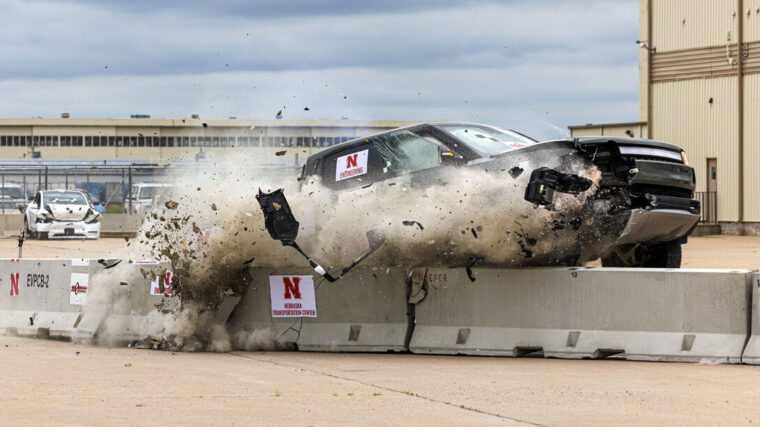
A recent crash test conducted by the University of Nebraska-Lincoln has raised questions about the readiness of U.S. highways for widespread electric vehicle (EV) adoption. The test, involving a 2022 Rivian R1T electric pickup truck, suggests that the increased weight of large EV’s with heavy battery packs and a lower center of gravity make commonly used highway guardrails and traffic barriers inadequate in reducing the risk of injury and death when an electric vehicle leaves the road.
“This is all in the midst of aging infrastructure, in which each state is trying to keep up and figure out how they invest in infrastructure improvements just based on what they currently know — and not keeping up with what’s in the future,” Jennifer Homendy, chair of the National Transportation Safety Board, said in an article from the University of Nebraska.
With EV sales in the U.S. reaching 1.6 million in 2023, a 60% increase from the previous year, and federal tax credits encouraging further adoption, ensuring road safety for these vehicles is crucial. The Environmental Protection Agency estimates that by 2032, more than half of new cars sold annually will need to be electric to meet new emissions standards. However, many U.S. roads and safety features were designed decades ago, potentially unprepared for the unique characteristics of EVs.
According to early estimates from the National Highway Traffic Safety Administration, more than 19,000 people died in 2023 in crashes where their vehicle left the roadway. This accounts for about half of all traffic fatalities, underscoring the critical importance of effective roadside safety infrastructure.
Cody Stolle, lead investigator for electric vehicle crash tests at the Midwest Roadside Safety Facility, explained, “Historically, there has not been any testing of electric vehicles with roadside barriers — what works, how the vehicles behave and how the barrier systems interact with the vehicle.”
The University of Nebraska’s tests, conducted since September 2023, have consistently raised concerns. In the July 1 test, a 7,000-pound Rivian R1T traveling at 62 mph crashed into a concrete barrier commonly used on freeways. While the vehicle was contained and redirected, the barrier suffered catastrophic damage, with concrete chunks sent flying and several 5,000-pound segments pushed back more than 10 feet.
Based on these results, researchers are calling for a comprehensive review and potential redesign of highway safety features to accommodate the unique characteristics of EVs, including their increased weight and lower center of gravity.
However, not everyone agrees that EVs should be singled out in this discussion. Following a test in January in which a Rivian R1T tore through a guardrail at the Midwest Roadside Facility, an article in MotorTrend argued that the issue extends beyond electric vehicles to include many popular trucks and SUVs with internal combustion engines.
“The takeaway from Nebraska’s crash test shouldn’t be fear-mongering over EVs’ mass. It should be to fear monger over how weak our nation’s guardrails are, period, especially against America’s most popular vehicles, which far outnumber EVs and are also quite heavy,” wrote Alexander Stoklosa in MotorTrend.
The MotorTrend article points out that many current vehicles, including best-selling pickup trucks, exceed the weight standards used in guardrail design. For instance, while the current Manual for Assessing Safety Hardware (MASH) standard defines a pickup truck at 5,000 pounds for testing purposes, popular models like the Chevrolet Silverado can weigh 5,500 pounds or more. Furthermore, the article highlights that many roadside barriers may not conform to the latest standards, as there is no federal mandate for their implementation or replacement.
Whether the issue is most pervasive in EVs or extends to heavy vehicles in general, the U.S. government is recognizing the need for safety upgrades. The 2021 Infrastructure Investment and Jobs Act allocated about $3 billion per year through 2026 to the Highway Safety Improvement Program (HSIP), which provides funding to states for projects that improve the safety of road infrastructure.
As U.S. Sen. Deb Fischer noted during a roundtable discussion on the issue at the University of Nebraska, “there’s huge ramifications across the board. It’s very important that we take it seriously and continue to try to find solutions.”
Photo courtesy of the University of Nebraska
The post Common highway barriers could be inadequate against heavy EVs, study suggests appeared first on Government Market News.
